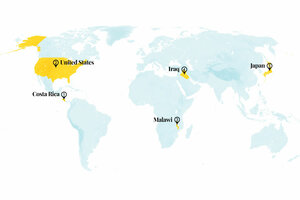Where school comes second and the town where bees come first

Staff
1. Costa Rica
“Sweet City,” a neighborhood near Costa Rica’s capital, prioritized its pollinators to also benefit people. Curridabat, an eastern suburb of San José, in 2015 bestowed citizenship onto its pollinators, trees, and native plants, and has since embedded environmental design into every corner of the city also called “Ciudad Dulce.”
The city’s approach identifies pollinators as “prosperity agents” and acknowledges their impact on the economy and nature’s connection to residents’ health. Since the plan’s implementation, Curridabat has transformed its streets into pollinator corridors, covered the city with educational information about bees and plants, and reforested. Annual global food production worth between $235 billion and $577 billion relies on pollinators, according to the Food and Agriculture Organization in 2018.
Costa Rica, home to over 5% of the planet’s biodiversity, aims for total decarbonization by 2050.
Why We Wrote This
In our progress roundup, freedom to grow and thrive was given to pollinators in a Costa Rican town that calls itself “Sweet City.” And in three prefectures of Japan, families can take their kids out of school for three days of their choice.
“The main strength of the vision lies in the municipal officials who, with commitment and empathy, create a place that aspires to a form of governance based on satisfaction with life and nature,” wrote Huberth Méndez, an adviser to the mayor’s office, on LinkedIn.
Sources: Ciudad Dulce Plan, The Guardian, El País, Food and Agriculture Organization
2. United States
Worker cooperatives are enabling a new generation of business owners. Americans over age 55 own 2.9 million businesses, employing 32.1 million people. But as many baby boomer employers reach retirement age without a succession plan, employee ownership is becoming an important option that can ease the disruption to workers in businesses that would otherwise shutter their doors.
In places like Baltimore’s Hampden neighborhood, workers have banded together to transform these workplaces. The Common Ground cafe closed after its owner retired, but workers reopened the beloved coffee shop with broad support. The Baltimore Roundtable for Economic Democracy, the local cooperative incubator, provided guidance, while its partner nonprofit, Seed Commons, gave financial support in the form of a non-extractive loan: Borrowers are required to pay back the loan using only profits. And the Hampden community, which had patronized the coffee shop for 25 years, contributed $26,000 to a GoFundMe drive.
By putting decision-making in employee hands, cooperatives can lead to better pay, working conditions, and productivity. In the U.S., New York has invested more than $1 million a year in cooperatives over the past decade; 91 called the city home in 2022. The Bay Area and Greater Boston are also leading the way, with 60 and 25 co-ops, respectively.
Sources: Yes! Media, Fifty by Fifty, Project Equity
3. Malawi
Farmers in Malawi are collaborating with meteorologists to make weather information more useful. Traditional knowledge has long been used to predict the weather, for example by observing changes in birdsong or insect behavior. These can shift based on humidity, barometric pressure, or other metrics, which are also tracked by weather scientists.
But climate change is producing weather that’s more erratic and harder to forecast, which makes it more difficult for farmers to know when to plant and harvest. So local leaders in Karonga, Malawi, implemented participatory scenario planning, which asks farmers to collaborate with conventional scientists to co-produce advice and communicate it effectively.
Under this program, weather scientists share their forecasts with farmers, and farmers provide ground-level data to scientists, resulting in trust-building as much as a data collection collaboration.
Participatory scenario planning has not yet been adopted at the national level in Malawi, but it has spread to about 15 districts since its implementation in 2014. The framework has been in use in Kenya for about a decade and is making headway in Ghana, Ethiopia, Niger, and Zimbabwe.
Sources: Proximate, Sustainability Institute
4. Iraq
A television channel is helping to preserve Syriac, an ancient language spoken primarily by Christians in Iraq and Syria. Syriac is related to Aramaic – the original script of the Bible – and was widely used in religious texts, but it has increasingly disappeared. After public demand prompted funding from the Iraqi government, television channel al-Syriania hopes to help Syriac speakers remain connected to the language.
About 40 staff members create programming on everything from news to cinema. While news bulletins are in classical Syriac, cultural programs are in a colloquial dialect. “It’s important to have a television station that represents us,” said Mariam Albert, a newscaster who speaks Syriac at home.
Syriac was prominent before Arabic began to dominate the region between the seventh and 11th centuries. After the U.S. invasion of Iraq in 2003, persecution by the Islamic State precipitated a further decline in the number of Christians living in the country. But sources of Syriac survive: Najeeb Michaeel Moussa, archbishop of Mosul, rescued a collection of Syriac manuscripts before the city fell to the Islamic State in 2014. Many of them are now preserved at the Digital Center for Eastern Manuscripts in Erbil, Iraq.
Sources: The World, The Arab Weekly, Al Jazeera
5. Japan
Japanese schools are giving children days off to spend time with family. In three prefectures, local governments are encouraging kids to take off up to three days of their choice per year. The goal is to improve the work-life balance for families in Japan, where many adults work or are on call through the weekend. The health ministry for years has recorded a link between Japan’s long working hours and high rates of depression.
In the parts of Okinawa, Oita, and Aichi that are offering the option, the program has a practical application, too. The days off may encourage parents to take vacations with their children on non-peak weekends for tourist travel. They also give kids the opportunity to see relatives who may live far away.
“Families and schools need to strike a balance between the opportunity for children to learn with their parents outside the classroom and the regular school hours missed due to such special time off,” said Makiko Nakamuro, a professor of education economics at Tokyo’s Keio University.
In Oita prefecture, 270 people applied to take part in the program in the first two months. One parent in Aichi prefecture used the time to take his child on a work trip. “Thanks to the program, I could show my son my work and have extra time with him,” said Shingo Horita, a civil servant.
Sources: The Asahi Shimbun, The Japan News, South China Morning Post

